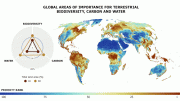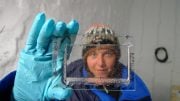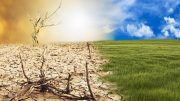
A study warns that climate change could abruptly push species beyond thermal exposure thresholds, leading to a sudden loss of habitat. This situation underscores the urgency to curb carbon emissions and strategically conserve biodiversity.
A recent study led by a University College London researcher, published in Nature Ecology & Evolution, reveals that climate change could suddenly thrust species beyond critical thresholds as they encounter unanticipated temperatures within their geographic habitats.
The study forecasts the timeline and locations where species worldwide may be subjected to potentially dangerous temperature changes due to climate change.
The research team from UCL, the University of Cape Town, the University of Connecticut, and the University at Buffalo analyzed data from over 35,000 species of animals (including mammals, amphibians, reptiles, birds, corals, fish, cephalopods and plankton) and seagrasses from every continent and ocean basin, alongside climate projections running up to 2100.
The researchers investigated when areas within each species’ geographical range will cross a threshold of thermal exposure, defined as the first five consecutive years where temperatures consistently exceed the most extreme monthly temperature experienced by a species across its geographic range over recent history (1850-2014).
Once the thermal exposure threshold is crossed, the animal is not necessarily going to die out, but there is no evidence that it is able to survive the higher temperatures – that is, the research projects that for many species there could be an abrupt loss of habitat due to future climate change.
The researchers found a consistent trend that for many animals, the thermal exposure threshold will be crossed for much of their geographic range within the same decade.
Lead author Dr. Alex Pigot (UCL Centre for Biodiversity & Environment Research, UCL Biosciences) said: “It is unlikely that climate change will gradually make environments more difficult for animals to survive in. Instead, for many animals, large swaths of their geographic range are likely to become unfamiliarly hot in a short span of time.
“While some animals may be able to survive these higher temperatures, many other animals will need to move to cooler regions or evolve to adapt, which they likely cannot do in such short timeframes.
“Our findings suggest that once we start to notice that a species is suffering under unfamiliar conditions, there may be very little time before most of its range becomes inhospitable, so it’s important that we identify in advance which species may be at risk in coming decades.”
The researchers found that the extent of global warming makes a big difference: if the planet warms by 1.5°C, 15% of species they studied will be at risk of experiencing unfamiliarly hot temperatures across at least 30% of their existing geographic range in a single decade, but this doubles to 30% of species at 2.5°C of warming.
Dr Pigot added: “Our study is yet another example of why we need to urgently reduce carbon emissions to mitigate the harmful effects climate change is having on animals and plants, and avoid a massive extinction crisis.”
The researchers hope that their study could help with targeting conservation efforts, as their data provides an early warning system showing when and where particular animals are likely to be at risk.
Co-author Dr Christopher Trisos (African Climate and Development Initiative, University of Cape Town) said: “In the past, we’ve had snapshots to show the impact of climate change, but here we are presenting the data more like a film, where you can see the changes unfold over time. This shows that for many species the risk is a bit like everything, everywhere, all at once. By animating this process, we hope to help direct conservation efforts before it’s too late, while also showing the potentially catastrophic consequences of letting climate change continue unchecked.”
The researchers say that this pattern of abrupt exposure may be an inevitable feature of living on a round planet – because of the shape of the Earth, there is more area available to species in environments near the hot end of what they are used to, such as in low-lying areas or near the equator.
A previous study by the same lead authors found that even if we stop climate change so that global temperatures peak and start to decline, the risks to biodiversity could persist for decades after. In another analysis similar to the current study, they found that many species facing unfamiliar temperatures will be living alongside other animals experiencing similar temperature shocks, which could pose grave risks to local ecosystem function.
Reference: “Abrupt expansion of climate change risks for species globally” by Alex L. Pigot, Cory Merow, Adam Wilson and Christopher H. Trisos, 18 May 2023, Nature Ecology & Evolution.
DOI: 10.1038/s41559-023-02070-4
The study was funded by the Royal Society, the Natural Environment Research Council, the National Science Foundation (US), the African Academy of Sciences, and NASA.









What? University College London needs to rewrite this.
It is unlikely the environments will gradually be more difficult to survive in, but the environments will have unfamiliar conditions, and this unfamiliarity may lead to a mass extinction of animals, in a survivable way with no evidence they would not survive? Which animals can’t move and who is deciding what ranges they can have? “abrupt exposure may be an inevitable feature of living on a round planet…there is more area available to species in environments near the hot end”? What shape do we need to make the planet so exposure to it is non-abrupt and evitable? Projections to 2100, so an abrupt 77 years? “even if we stop climate change so that global temperatures peak and start to decline, the risks to biodiversity could persist”, could they really and if so then why bother, but the authors want to stop the climates on Earth from changing? How do they propose we make them permanent?
I’m sorry, maybe the science in this is perfection, and I didn’t check because it would cost me thirty bucks, but this writeup’s doubletalk is like someone put a climate phrasebook in a blender.
Death is the engine of evolution. If an ecological niche is vacated by the extinction of a species, it creates an opportunity for an existing competing species, or for a mutation in the current dominant species. I suspect that most species are more resilient than assumed. It would seem that those most at risk are alpine species living around the timberline, near the summit of the local peaks. But, that isn’t much different from the existential threat created by those adapted to high elevations because their mountains are being eroded under their feet. Eventually, their habitat will be changed significantly by the lowering of the elevation by erosion. It is a matter of rate. A peneplain near sea level offers less opportunity for biological diversity than a high mountain range.
Those that can move laterally, almost certainly will. We may once again have crocodilians, or similar tropical creatures, living in the Arctic. One thing we know with certainty: plants cannot root and prosper in ice. So, warming may be challenging, but it is not the same kind of barrier that ice presents.
It is interesting that warming-skeptics are commonly denigrated as being ‘climate deniers.’ Yet, the typical climate alarmist is someone who is unhappy with a world that is getting warmer and changing the biodiversity structure of the planet. They claim that humans only are responsible for the changes in the world, which they disapprove of, and they apparently would like the world to stay the way it was 150-years ago. Paleontologists have demonstrated that the world has never worked that way. Who are the ‘deniers?’